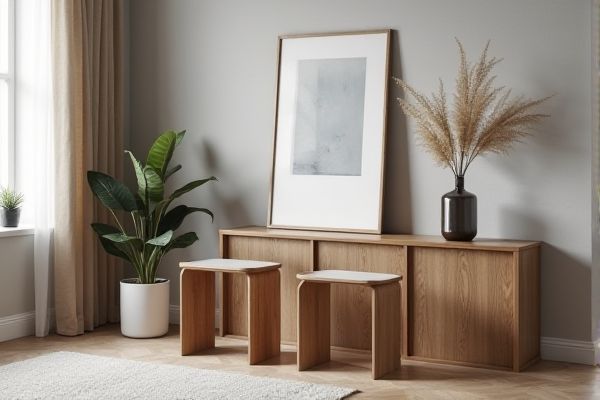
Nesting tables offer versatile, space-saving solutions by fitting neatly under one another, making them ideal for small living areas, while console tables provide a stylish and practical surface along walls or entryways for decor and storage. Discover how each type can enhance Your home's functionality and aesthetics by reading the rest of the article.
Table of Comparison
| Feature | Nesting Tables | Console Tables |
|---|---|---|
| Definition | HTML tables placed inside another table cell for hierarchical data. | Tabular data output formatted in command-line interfaces. |
| Use Case | Displaying complex, multi-level data structures in web pages. | Quick, readable tabular data in terminal or debugging tools. |
| Performance | Can slow down page rendering if deeply nested. | Fast output with minimal formatting overhead. |
| Readability | May reduce readability if overused or deeply nested. | Clear and concise for console output, easy to scan. |
| Complexity | Higher complexity in HTML structure and CSS styling. | Simple structure, dependent on console or library capabilities. |
| Accessibility | Potential issues with screen readers due to complexity. | Depends on terminal capabilities; usually limited. |
| Customization | Flexible styling with CSS for appearance and layout. | Limited styling, mostly text-based color and alignment. |
Overview: Nesting Tables vs Console Tables
Nesting tables are compact, multi-tiered furniture pieces designed to slide neatly under one another, optimizing space while offering flexible surface areas for living rooms. Console tables are slim, versatile tables typically placed against walls or behind sofas, providing decorative display space or storage in entryways and hallways. Both serve functional and aesthetic purposes but differ significantly in design, placement, and space utility.
Design and Aesthetic Differences
Nesting tables feature a compact, space-saving design with smaller tables fitting neatly under larger ones, offering versatility and a modern aesthetic ideal for minimalist interiors. Console tables typically have a slim, elongated form designed to be placed against a wall, emphasizing elegance and functionality through their decorative details and surface space. The design of nesting tables centers on practicality with a cohesive look when stacked, whereas console tables prioritize statement-making appeal with varied materials and styles.
Space-Saving Benefits
Nesting tables offer superior space-saving benefits by providing multiple tabletops that can be stacked or separated as needed, ideal for compact living areas. Console tables are narrow and designed to fit against walls or behind sofas, optimizing limited floor space without compromising surface area. Your choice depends on whether you need flexible, multifunctional furniture or a sleek, stationary surface.
Functionality and Versatility
Nesting tables provide exceptional functionality by offering multiple surfaces that can be conveniently stacked or separated, maximizing space efficiency in small or dynamic living areas. Console tables excel in versatility by serving as narrow, multi-purpose furniture pieces ideal for entryways, hallways, or behind sofas, often incorporating storage or display options. Both options enhance interior design flexibility, but nesting tables adapt better to changing spatial needs while console tables prioritize decorative and storage utility.
Material and Construction Comparison
Nesting tables typically feature lightweight materials such as engineered wood, metal frames, or tempered glass, designed for easy maneuverability and space-saving functionality. Console tables are often constructed from solid hardwoods or metal with robust joinery techniques, focusing on durability and decorative appeal. Choosing between the two depends on your need for portability and compact storage versus sturdy structure and aesthetic presence.
Ideal Room Placement
Nesting tables are ideal for living rooms or small spaces where flexible surface area is needed, as they can be neatly stacked to save space and pulled out when required. Console tables fit perfectly in entryways, hallways, or behind sofas, providing a narrow surface for decorative items or keys without occupying much floor space. Both options optimize room functionality but cater to different spatial needs and aesthetics.
Storage and Organization Features
Nesting tables provide versatile storage by fitting smaller tables within larger ones, maximizing space efficiency and offering flexible organization options for various room sizes. Console tables feature built-in shelves, drawers, or compartments designed for storing keys, mail, and decorative items, optimizing entryway or hallway organization. Both types enhance home storage solutions but cater to different spatial and functional preferences.
Style Compatibility with Interior Trends
Nesting tables offer sleek, space-saving designs that complement modern minimalist and contemporary interiors, enhancing functionality without clutter. Console tables provide versatile surfaces ideal for entryways or living rooms, fitting well with traditional, transitional, and eclectic decor styles. Choose Your table type based on the desired blend of style and practical use to seamlessly integrate with your interior trend.
Pros and Cons of Nesting Tables
Nesting tables offer excellent space-saving benefits by stacking smaller tables neatly under a larger one, making them ideal for compact living areas or multifunctional spaces. These tables provide versatile surface options and can be easily separated for extra seating or display needs, yet they may lack the visual impact or storage capacity of console tables. Your choice depends on whether you prioritize flexibility and compactness or decorative appeal and additional storage.
Pros and Cons of Console Tables
Console tables offer versatile placement options in narrow spaces such as hallways or entryways, providing both storage and decorative functions without occupying much floor area. They typically have a fixed size and structure, limiting their adaptability compared to nesting tables that can be stacked or separated for multiple uses. Durability and style variety make console tables ideal for long-term furniture investment, though they lack the compact storage flexibility that nesting tables provide.
 homyna.com
homyna.com